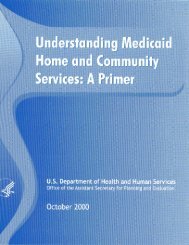STRATEGIC PLAN - ASPE - U.S. Department of Health and Human ...
STRATEGIC PLAN - ASPE - U.S. Department of Health and Human ...
STRATEGIC PLAN - ASPE - U.S. Department of Health and Human ...
Create successful ePaper yourself
Turn your PDF publications into a flip-book with our unique Google optimized e-Paper software.
CHAPTER 2: <strong>Health</strong> careagencies on aging, child care providers, early educationproviders, <strong>and</strong> tribal governments.American Indians <strong>and</strong> Alaska Natives<strong>Health</strong> services are provided to American Indians <strong>and</strong>Alaska Natives through several means. In FY 2006, IHSprovided health care services directly at 33 hospitals,59 health centers, <strong>and</strong> 50 health stations <strong>and</strong> supportsessential sanitation facilities (including water supply,sewage, <strong>and</strong> solid waste disposal) for American Indian/Alaska Native (AI/AN) homes <strong>and</strong> communities. IHSpr<strong>of</strong>essional staff include approximately 2,700 nurses,900 physicians, 400 engineers, 500 pharmacists, 300dentists, <strong>and</strong> 150 sanitarians. IHS also employs variousallied health pr<strong>of</strong>essionals, such as nutritionists, healthadministrators, <strong>and</strong> medical records administrators.More than half <strong>of</strong> the IHS budget is now used toprovide funding for American Indian Tribes, tribalorganizations, <strong>and</strong> Alaska Native corporations thatchoose to contract or compact with IHS to providehealth care under the Indian Self-Determination <strong>and</strong>Education Assistance Act <strong>of</strong> 1975 (Public Law 93-638),as amended. These entities administer 15 hospitals,221 health centers, 9 residential treatment centers, 97health stations, <strong>and</strong> 176 Alaska village clinics. BothIHS <strong>and</strong> tribal entities purchase additional health careservices from private providers. xHHS <strong>and</strong> the U.S. <strong>Department</strong> <strong>of</strong> Veterans Affairs (VA)have entered into a Memor<strong>and</strong>um <strong>of</strong> Underst<strong>and</strong>ing toencourage cooperation <strong>and</strong> resource sharing betweenIHS <strong>and</strong> the Veterans <strong>Health</strong> Administration. The goalis to use the expertise <strong>of</strong> both organizations to deliverquality health care services <strong>and</strong> enhance the healthstatus <strong>of</strong> AI/AN veterans. An interagency advisorycommittee, involving IHS <strong>and</strong> the Office <strong>of</strong> Minority<strong>Health</strong> (OMH) in OPHS, identifies health disparities forAmerican Indians <strong>and</strong> Alaska Natives compared to thegeneral U.S. population.People With DisabilitiesThe four goals included in The Surgeon General’s Callto Action to Improve the <strong>Health</strong> <strong>and</strong> Wellness <strong>of</strong> Personswith Disabilities are as follows:• Increase underst<strong>and</strong>ing nationwide that peoplewith disabilities can lead long, healthy, <strong>and</strong>productive lives;• Increase knowledge among health carepr<strong>of</strong>essionals <strong>and</strong> provide them with tools toscreen, diagnose, <strong>and</strong> treat the whole person with adisability with dignity;• Increase awareness among people with disabilities<strong>of</strong> the steps they can take to develop <strong>and</strong> maintain ahealthy lifestyle; <strong>and</strong>• Increase accessible health care <strong>and</strong> supportservices to promote independence for people withdisabilities.Virtually every HHS operating <strong>and</strong> staff division hasinitiatives to support this critical effort, headed byOPHS’s Office <strong>of</strong> the Surgeon General (OSG) <strong>and</strong>OD. Moreover, a broad array <strong>of</strong> Federal agencies,including the U.S. <strong>Department</strong>s <strong>of</strong> Agriculture, Defense,Education, Housing <strong>and</strong> Urban Development, Interior,Justice, Labor, Veterans Affairs, <strong>and</strong> the NationalScience Foundation, the Office <strong>of</strong> National DrugControl Policy, <strong>and</strong> the Social Security Administration,as well as many non-Federal stakeholders, havecommitted to pursuing these goals.Of particular note is HRSA’s effort to provide health<strong>and</strong> community resource information <strong>and</strong> peer supportto families having children <strong>and</strong> youth with specialhealth care needs. Family-to-Family <strong>Health</strong> InformationCenters, funded under the Dylan Lee James FamilyOpportunity Act, 3 will be family-run, statewide centersin every State <strong>and</strong> the District <strong>of</strong> Columbia <strong>and</strong> willbe responsible for developing partnerships with thoseorganizations serving these children <strong>and</strong> their families.They also will be charged with monitoring the progress<strong>of</strong> programs with responsibility for payment <strong>and</strong> directservices <strong>of</strong> this population through a statewide datacollection system.3 The Dylan Lee James Family Opportunity Act was passed as aprovision to the Deficit Reduction Act <strong>of</strong> 2005 (Public Law 109-171).HHS Strategic Plan FY 2007-201235
















